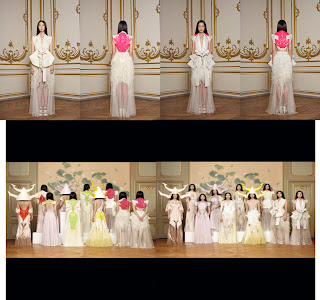By Tim Blanks
The last time Riccardo Tisci showed a couture collection for
Givenchy, the zipper pulls were bones. This season, they were wings. Fashion's favorite goth took flight with a new obsession: Japan. Not the land of obis and geishas, he said, but the Japan of robot toys and the dancer Kazuo Ohno, whose intensely ritualized style of performance, called Butoh, was a huge influence on Tisci's friend, the singer Antony Hegarty. When Ohno died, Antony and the Johnsons performed a tribute concert that so inspired Tisci, the dead man became a sort of muse for the designer. And this was the result. According to Tisci, Ohno provided the romance, the melancholy, and the palette (the color of dried flowers). Robots, meanwhile, influenced the appliqués, the shoes, and the huge hats by Philip Treacy (couple this with Armani last night, and Treacy is clearly the go-to guy for sci-fi headgear).



The detail was as crazily consuming as last season's. One outfit required 2,000 hours of cutting and 4,000 hours of sewing. A single pair of trousers had 90 meters of plissé. On this scale, appreciation of the clothes as they solemnly rotated from hangers in a reverentially hushed salon on the Place Vendôme became an almost academic exercise, like examining works of art in a gallery. Maybe not such a bad analogy, given the extraordinary appliqué on a bolero that crossed a robot's face with a Catholic cross, or the organza that was laser-cut and appliquéd on layers of chiffon and tulle to create a three-dimensional spread of vermilion wings. One gown featured a Japanese crane, again appliquéd, that rose phoenixlike from a cloud of feathers. Massive bird's wings were folded across a sheer skirt. The Swarovski crystals and pearls that were crusted on the bodice of another dress began to pop like fish eyes as the dress moved.
The craft was undeniable, though in the end, like Ohno's favorite dried flowers, the clothes lacked some of the rude life that Tisci stuffed into his recent menswear collection.














































.jpg)


